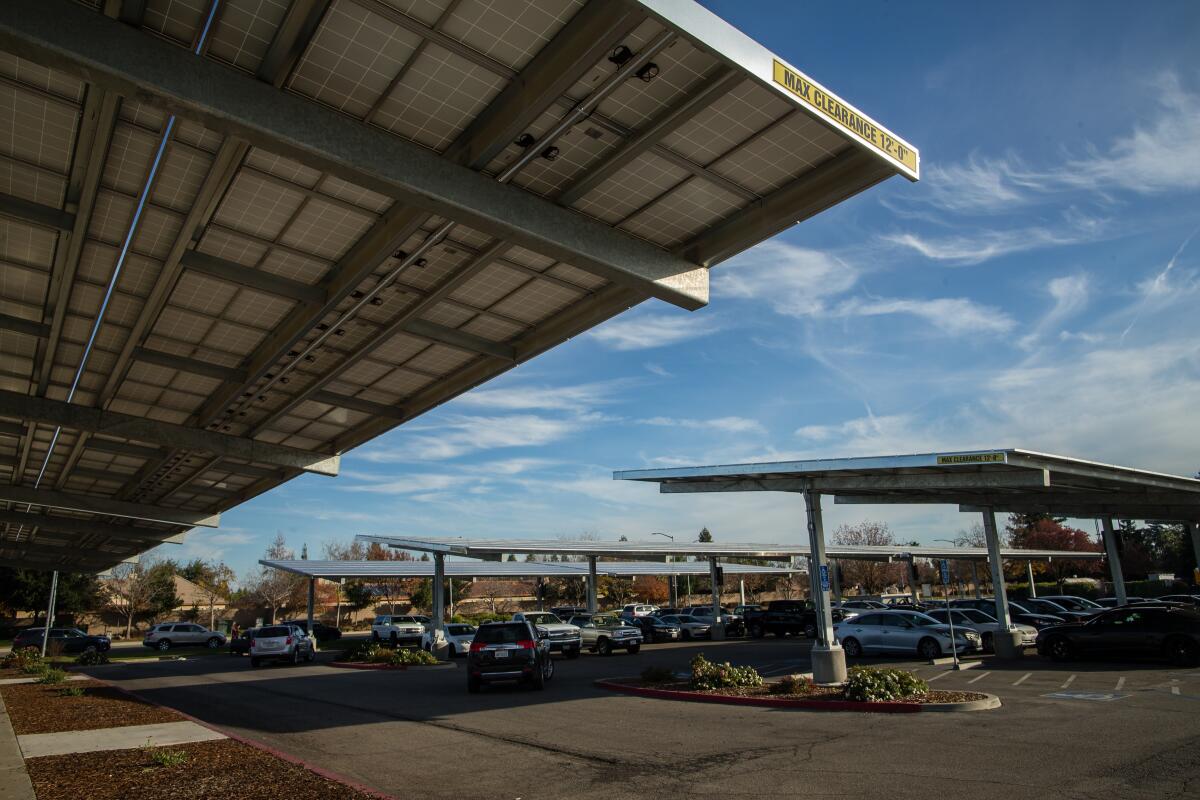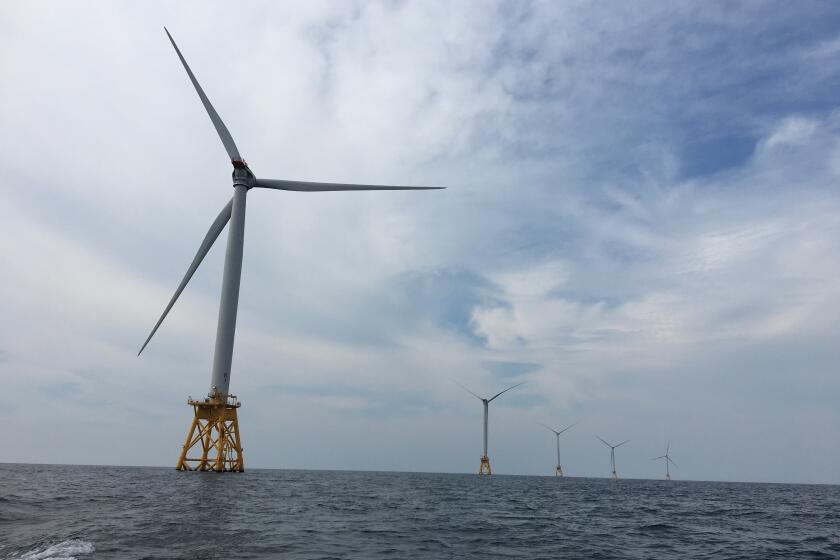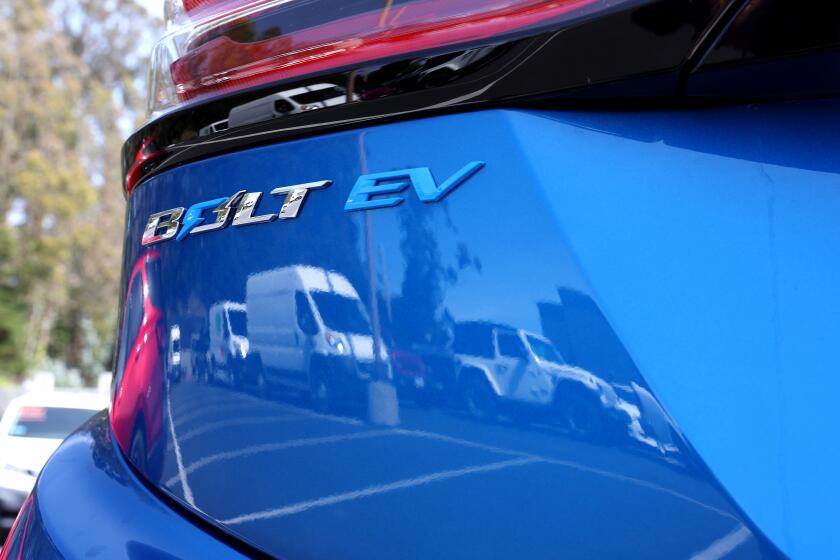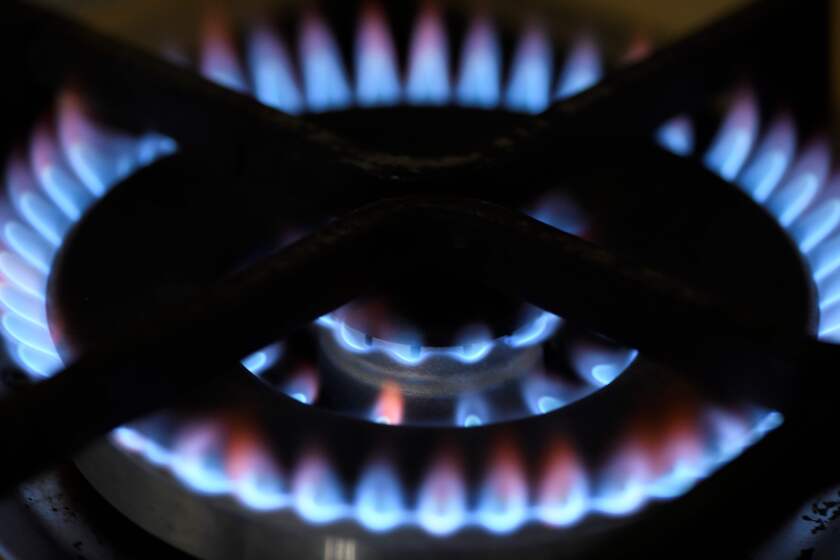Editorial: California needs a lot more solar. Why not put panels along highways and parking lots?

- Share via
California is racing to build enough solar panels, wind turbines and battery storage to meet its carbon-cutting mandates and prepare its electrical grid for worsening heat waves and growing energy demand.
But increasing renewable energy by covering far-off, undeveloped areas with solar and wind farms raises its own environmental concerns. That’s why California needs to think creatively and find ways to put more solar energy in already built-out places, including rooftops and parking lots, canals and agricultural fields, so we can slow the climate crisis without harming sensitive land, like the habitat of threatened Joshua trees or Mojave Desert tortoises.
Legislation by state Sen. Josh Becker (D-Menlo Park) would do just that, by requiring state transportation officials to develop a plan to install solar panels along underutilized rights-of-way, the ribbons of state-owned land along highways across California. This is such a commonsense idea that it’s surprising to learn California isn’t already doing it.
California needs to quadruple the power it gets from the sun and wind to meet its climate goals. But there’s only so much land available. Where should we place more clean energy?
Senate Bill 49 would start to unlock the potential along California’s 15,000 miles of state highways, by giving Caltrans about two years to develop a plan to lease state-owned rights-of-way to utility companies or private developers to install solar panels, battery storage and transmission lines. The bill would require Caltrans to set goals for renewable energy generation along highways by 2030 and 2045, and to track its progress each year.
This idea should be a no-brainer for lawmakers.
“This is land we already own, and why don’t we take advantage of that land?” Becker said. “There’s massive potential there.”
The bill also proposes financial incentives to make it more affordable for businesses, apartment complexes, schools and other property owners to install solar canopies over their parking lots, making them sources of shade and renewable energy. The details are still being determined — language that would have used sales tax exemptions was stripped from the bill — but Becker said a different funding mechanism will be included in the final version.
SB 49 was passed unanimously by the Senate Transportation Committee last month. But in order to advance, it needs to clear the Senate Appropriations Committee by the end of this week.
The trend toward bigger, heavier electric vehicles is not good for the planet. Regulators need to push back to encourage more smaller, affordable models from carmakers.
California wouldn’t be the first to do this. Oregon built the nation’s first solar highway project back in 2008, an array of nearly 600 panels at an interchange south of Portland. Since then, similar systems have been installed along highways in a number of states including Georgia and Massachusetts. Lawmakers in Washington state last year passed a law to provide tax incentives to build solar canopies over big commercial parking lots, and France now requires them on any lot with more than 80 spaces.
In California, the need to be more inventive with the siting of renewable energy is more important than ever, especially after the state Public Utilities Commission’s decision to slash incentives for rooftop solar has increased uncertainty over how fast homes and businesses will continue to go solar.
It just makes sense, economically and environmentally, to concentrate solar projects in areas that are already developed, especially if they are near cities, factories or other locations where there’s already demand for electricity. The state could generate revenue by leasing the land to solar companies or save money by purchasing the electricity they generate at lower rates. Solar panels could be paired, wherever possible, with batteries to store the energy to use after the sun sets, especially on the hottest evenings when it’s needed most to guard against blackouts that we only narrowly avoided last year.
New York just became the first state to ban gas hookups from new buildings to fight climate change and air pollution. What’s preventing California from doing the same?
Taxpayers could benefit. A 2020 study by University of Texas at Austin researchers found that because of California’s high electricity rates, it could generate more revenue than any other state from placing solar along its highway interchanges, more than $300 million a year.
The Biden administration has encouraged state transportation agencies to use highway rights-of-way “for pressing public needs relating to climate change,” including “renewable energy generation and electrical transmission and distribution projects” and charging stations.
A Caltrans-commissioned report in 2020 laid some of the groundwork for building solar arrays in highway rights-of-way, but the agency needs a push to move beyond saying it is “interested” in these projects and actually join other states in making them happen. Even without legislation, is there anything preventing Gov. Gavin Newsom’s administration, and his appointees at Caltrans, from moving forward on solar highway projects today?
California needs to roughly quadruple its wind and solar energy by 2045, and will face surging demand for electricity as people replace their polluting, fossil-fueled cars and appliances with zero-emission electric ones. The state is not on track to meet its legal obligations to cut greenhouse gas emissions 40% below 1990s levels by 2030.
Solar highways and canopies are a relatively low-stakes solution, and one of many tools California needs to start using as quickly as possible to get on course for a more livable future.
More to Read
A cure for the common opinion
Get thought-provoking perspectives with our weekly newsletter.
You may occasionally receive promotional content from the Los Angeles Times.













